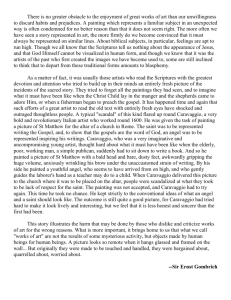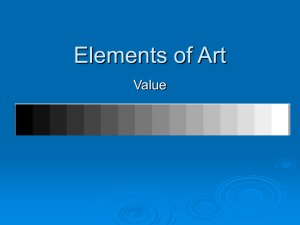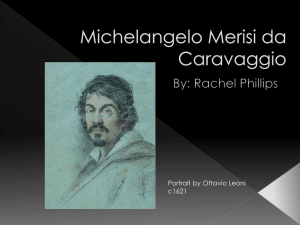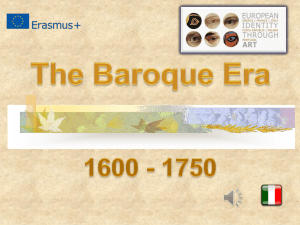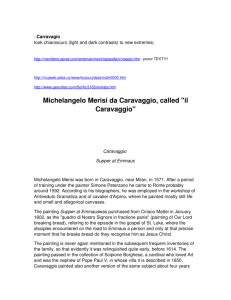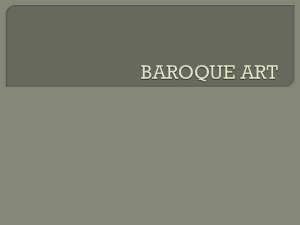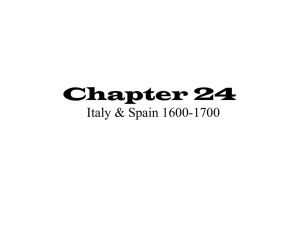ArtistResearchProject
advertisement
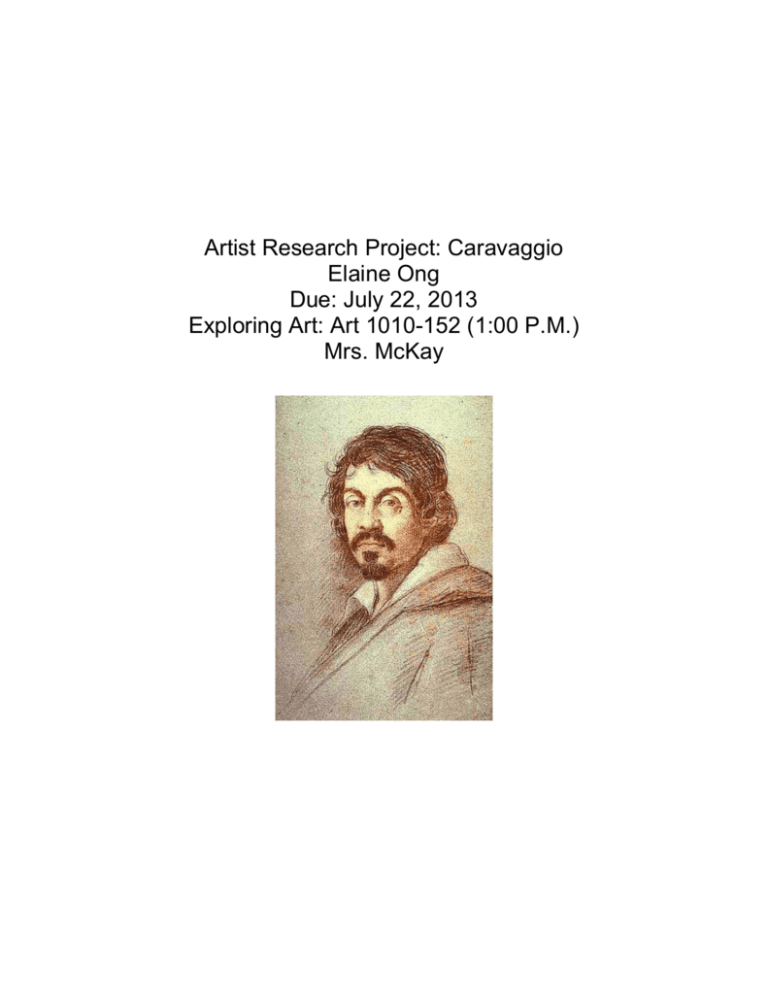
Artist Research Project: Caravaggio Elaine Ong Due: July 22, 2013 Exploring Art: Art 1010-152 (1:00 P.M.) Mrs. McKay Prior to researching the artist, Caravaggio, I didn’t know anything about him other than that he was an Italian painter. After researching him, I learned that despite his overwhelming success, his personality and actions interfered with his life, which ultimately led to the death of his reputation in his later years. I was at a loss for what artist to choose, so I went down the list of artists and did some brief research on them. The one that caught my eye was Caravaggio because his paintings consisted of well known figures in interesting scenarios and/or poses. As a preconceived idea, I assumed he contributed to the Renaissance paintings, and was inspired by the Renaissance because he’s Italian and he painted in the 16th and 17th centuries. I also had a preconceived idea that he was a religious artist; more specifically, Roman Catholic. When I started my research, I expected to find that he was a well-renowned artist, due to the talent he displayed in his work, and that he followed in the footsteps of the artists before him. Also, that he was a prominent figure in the Renaissance art. Michelangelo Merisi or Amerighi da Caravaggio was born on September 29th, 1571 in Milan, where his father was an architect-decorator for the Marchese of Caravaggio. His mother had come from a propertied family of the same district as well. The family later moved to Caravaggio in 1576 to escape the plague in Milan. His father passed away in 1577. The same year that Caravaggio’s mother died, 1584, is the year he began his four-year apprenticeship for Simone Peterzano a painter from Milan. After quarrels and the wounding of a police officer in Milan, he left for Rome in 1592, where he performed hack-work for Giuseppe Cesari (Pope Clement VIII’s favorite artist) months later. After his informal education, Caravaggio left Cesari to make his own way. His friendships had a large influence on his artwork and career. His relationship with Prospero Orsi, already established in the profession, had introduced him to influential collectors, while his relationship with Onorio Longhi introduced him to the world of Roman street-brawls. His artwork was influenced immensely by his friendship with the sixteenyear-old artist, Mario Minniti in Sicily. His first artwork, The Fortune Teller with more than one figure was a painting of Mario being cheated by a gypsy girl. This kind of style and theme was a new one for Rome, and proved to be very influential for the next centuries to come. But that was the issue; the theme was too early for its time, and Caravaggio sold it for close to nothing. He continued to use Minniti as a model for his paintings, along with other adolescent models. His work The Cardsharps was a painting that showed yet again, another naive, privileged youth falling prey to cheating in cards. His work was psychologically complex, and this painting is most likely his first true masterpiece. It attracted Cardinal Francesco Maria Del Monte, a leading connoisseur in Rome, and set off an artistic popar spark within Del Monte’s wealthy art-loving circle. His artwork changes slightly from Realism and naturalism on religious themes and spirituality, to Baroque with the acute observation of physical and psychological reality that brought popularity from his frequent dark problems in religious commissions. He had been in many brawls, but despite his criticism in violence, his reputation increased and Caravaggio was envied. He had a handful of encounters with the law while in Rome, and was imprisoned for multiple assaults, including the killing of an opponent after an argument over the score in a game of tennis. Caravaggio left the city and moved between hiding places until he arrived in Naples in 1607, where he painted while waiting for a pardon from the pope. His painting style changed, where the dark and urgent nature of his paintings seemed to have reflected his own desperate state of mind. The few historical and political influences on his life and work include the plague in Milan that forced his family to relocate to Rome, and the trouble he had got into with the Roman law, that forced him to constantly be on the run until he found refuge in Naples. Caravaggio’s artwork consisted of many different subjects and figures. He mostly painted human figures and bowls of fruit, occasionally a combination of both. He painted many stilllifes. His paintings often included figures that weren’t his actual models (i.e. cupid, Saint Matthews, Saint Paul, David & Goliath, etc.) The subject matter of the artist changed over time with how he started his career painting youthful models and bowls of fruit to darker, more psychologically deep paintings often centered around religion later on in his life. He painted many fantasy and scenery artworks. The media he used was oil, and it never changed. His style was known as realism and naturalism even to this day. His works are also very prominent in the Baroque category. Although Caravaggio seems to have stayed in the Milan-Caravaggio area, it is possible he visited Venice and saw the artworks of Giorgione. Federico Zuccari later accused him of imitating Giorgione and Titian in his works. His style seemed to be influenced by the famous works and treasures of Milan, including Leonardo da Vinci’s Last Supper along with the Lombard art style that valued simplicity and attention to naturalistic detail. His style didn’t change much, as he continued to use naturalism and realism to depict the details as he saw them, no matter how flawed they are. His artwork did get darker during his later years though. He was part of the Baroque movement. His artwork communicated the psychologically complex, yet realistic views of life and religion, all the while showing the naive society in his work. The public response for Caravaggio varied in mostly two groups. Many enjoyed his artwork, and he became a sort of “favorite” for wealthy art-enthusiast circles. He had great success even with just his first public commissions, and never lacked commissions or patrons. In spite of that, he handled his success poorly as he was jailed on multiple occasions, vandalized his own apartment, and in the end, had a death warrant issued for him by the Pope for killing another person. I personally think that his work is outstanding. His style is really nice, and his skills over extraordinary. Paired with his own ability to build scenarios that provoke deep thinking is what I like best about his work. It really makes you think and it lures you in to examine every fine detail as if the painting tells a story. Out of everything I learned through researching Caravaggio, I personally think that the most important things I learned about him was his life outside of his artwork, and how it affected his art. I found it interesting that his success in the earlier years in his life slowly dwindle down to a life of despair in his later days when he’d get into brawls, and one time even kill someone, which caused the Pope to issue a death warrant for him. Especially at the end of his life when he tried to leave on a ship, but it took off with his belongings, which resulted in his death on the beach several days later. The three most important points about Caravaggio that I deem significant are that he was a rule breaker in not only the artistic aspect, but social aspect as well; he depicted religious scenes with unprecedented approachability; and he rose up from spending his first years in absolute poverty. I think Caravaggio’s work is very influential and significant, especially since he more or less started a new, unprecedented style, dealing with critique head on with a style that had never been seen before. He later served as inspiration for artists such as Rubens, Velasquez, and Rembrandt. WORKS CITED Artble. "Caravaggio." Artble: The Home of Passionate Art Lovers. N.p., n.d. Web. 22 July 2013. Caravaggio Foundation. "The Complete Works: Caravaggio." The Complete Works: Caravaggio. Caravaggio Foundation, 14 Mar. 2013. Web. 22 July 2013. Pioch, Nicolas. "Caravaggio, Michelangelo Merisi Da." WebMuseum, Paris. WebMuseum, 19 Sept. 2002. Web. 22 July 2013. The National Gallery. "Michelangelo Merisi Da Caravaggio." The National Gallery, London: Western European Painting 1250–1900. N.p., n.d. Web. 22 July 2013. Wikipedia. "Caravaggio." Wikipedia. Wikimedia Foundation, 21 July 2013. Web. 22 July 2013. ARTWORK Fortune Teller: (1594) The Cardsharps: (1594) Basket of Fruit: (1596) Medusa: (1597) David and Goliath: (1599) Amor Victorious: (1602) Denial of Saint Peter: (1610) Martyrdom of Saint Ursula: (1610--last known piece)
